Huawei officially releases its own operating system - Hongmeng OS! (picture)
Under the technological war between China and the United States, countless Chinese people have been fighting for the rise of China for countless days and nights. Today, my family’s achievements have finally begun to take shape!

Recently, at the Huawei Developer Conference being held at the Songshan Lake headquarters in Dongguan, Huawei Consumer Business CEO Yu Chengdong officially announced the "world-breaking" Hongmeng OS. 's arrival
Hongmeng OS has four major technical features
The reason why Hongmeng OS was developed was not only to avoid the embarrassment of being choked during critical periods. In this regard, Yu Chengdong also He said that the current Android/Linux system kernel code is huge and redundant, making it difficult to ensure a smooth experience on different terminals. At the same time, the multi-terminal Internet also puts forward higher requirements for device security, requiring software ecology and hardware binding, which reduces user experience and development efficiency. Therefore, Hongmeng OS came into being. 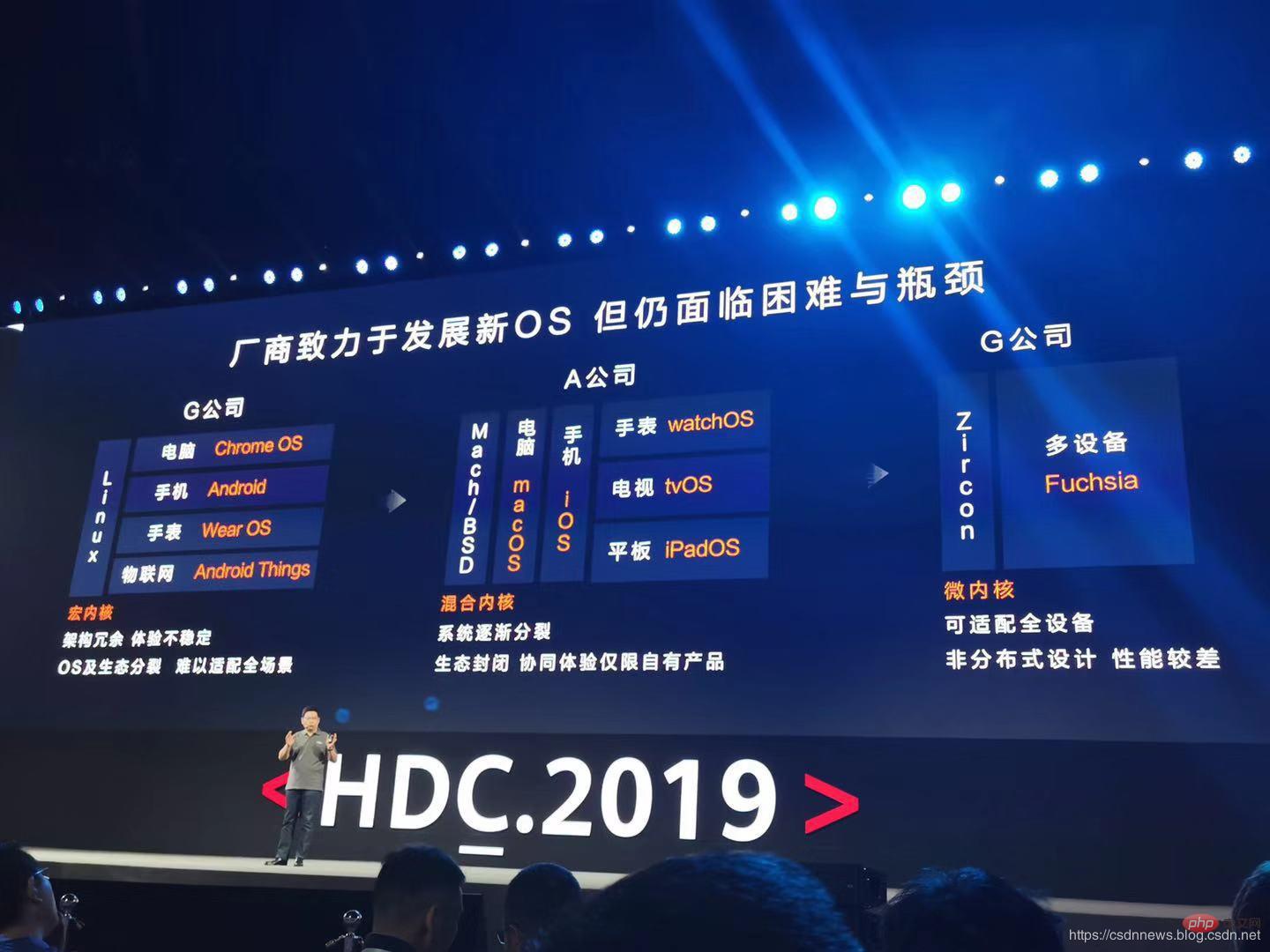
Although both are based on microkernels, Hongmeng OS is different from the microkernel of Google Fuchsia. Hongmeng OS is a full-scenario distributed OS based on microkernels. As the name suggests, it is not only for... It is a full scenario for smart large screens, wearables, cars, audio, watches, mobile phones, PCs and other devices, as well as distributed architecture support, which can provide a natural and smooth kernel-level security ecosystem.
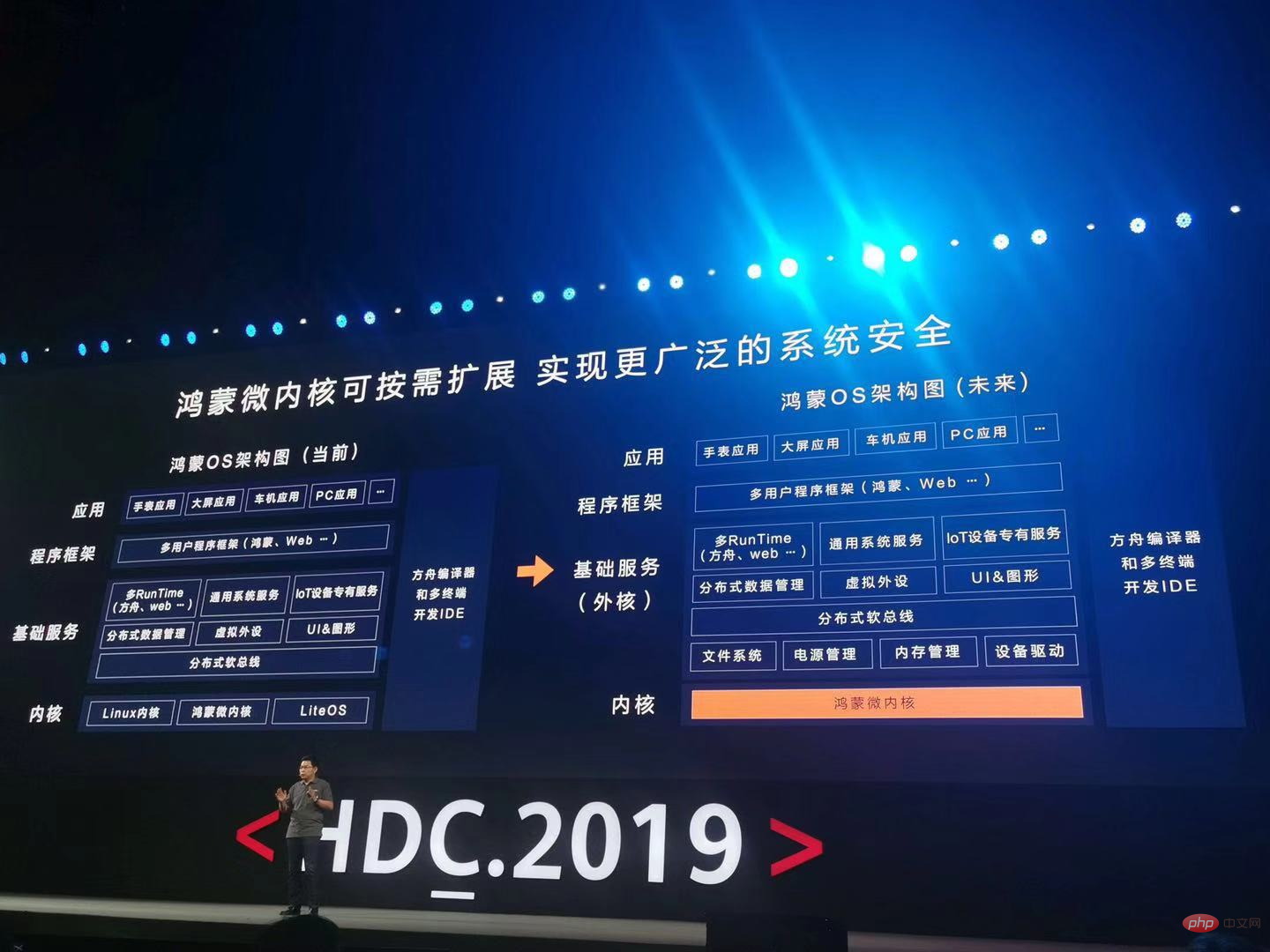 In terms of breakdown, Yu Chengdong said that Hongmeng OS has the following four major technical advantages:
In terms of breakdown, Yu Chengdong said that Hongmeng OS has the following four major technical advantages:
Distributed architecture: achieving seamless collaborative experience across terminals
Hongmeng OS's "distributed OS architecture" and "distributed soft bus technology" use the four major capabilities of public communication platform, distributed data management, distributed capability scheduling and virtual peripherals to provide corresponding distributed The difficulty of implementing the underlying technology of the application is shielded from application developers, allowing developers to focus on their own business logic and develop cross-terminal distributed applications as if they were developing the same terminal. It also enables end consumers to enjoy powerful cross-terminal business collaboration capabilities for all users. Seamless experience brought by the scene.
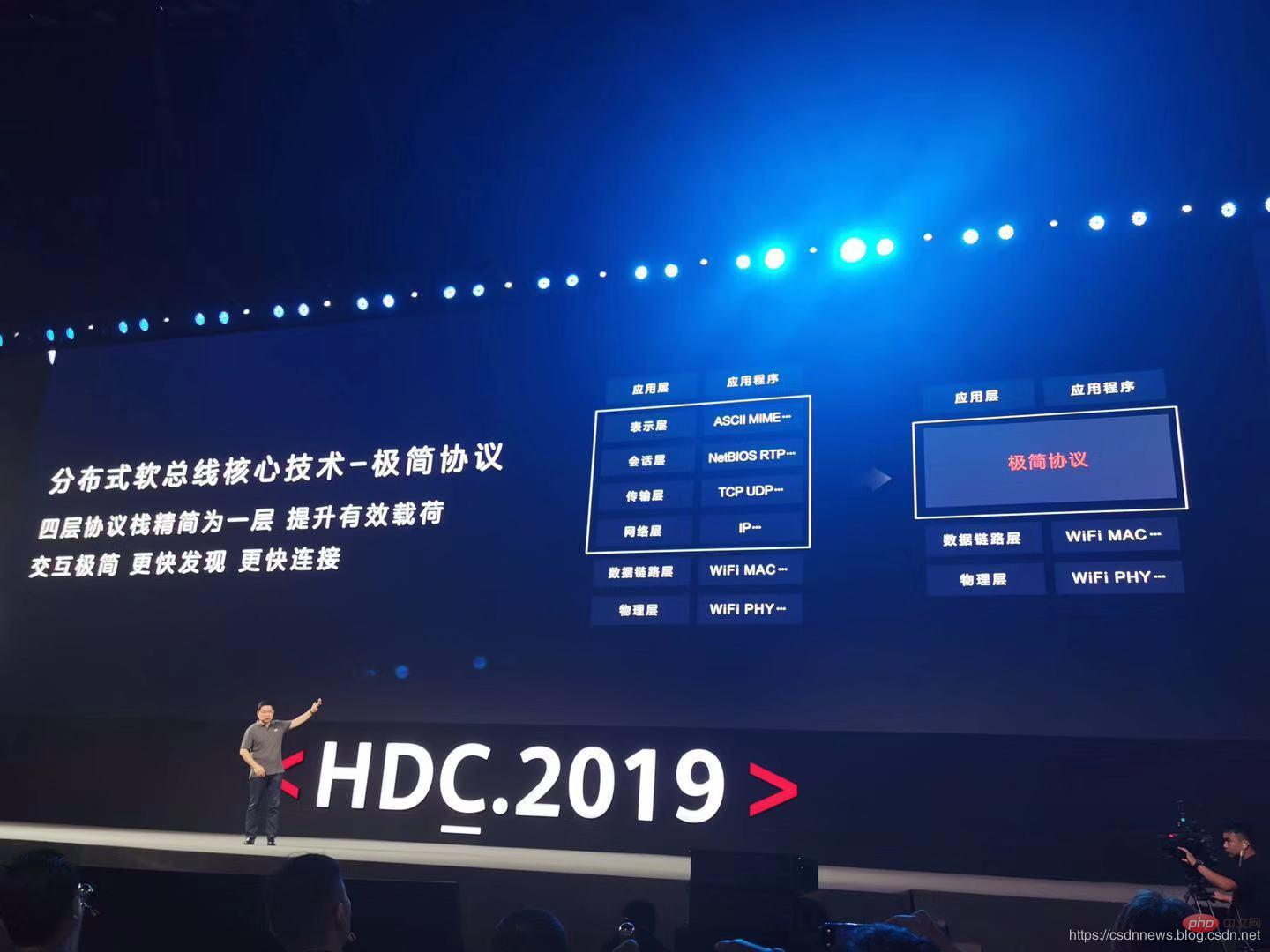 Born smooth: two major technologies, deterministic latency engine and high-performance IPC
Born smooth: two major technologies, deterministic latency engine and high-performance IPC
Hongmeng OS uses two major technologies, deterministic latency engine and high-performance IPC Solve the problem of insufficient performance of existing systems. The delay-determining engine can allocate task execution priorities and deadlines in the system for scheduling before task execution. Task resources with high priority will be given priority to ensure scheduling, and application response latency is reduced by 25.7%. The compact structure of Hongmeng microkernel greatly improves IPC (inter-process communication) performance, and process communication efficiency is increased by 5 times compared with existing systems.
Kernel security: Reshape the trusted security of terminal devices based on microkernel architecture
Hongmeng OS adopts a new microkernel design, with stronger security features and low latency. Characteristics such as extension. The basic idea of microkernel design is to simplify the kernel functions, implement as many system services as possible in the user mode outside the kernel, and at the same time add mutual security protection. Microkernel only provides the most basic services, such as multi-process scheduling and multi-process communication.

Hongmeng OS applies microkernel technology to the Trusted Execution Environment (TEE) to reshape trusted security through formal methods. Formal methods are an effective means to use mathematical methods to verify that the system is correct and free of loopholes from the source. Traditional verification methods such as functional verification, simulated attacks, etc. can only be verified in selected limited scenarios, while formal methods can verify all software running paths through data models.
Ecological Sharing: Unified IDE supports one-time development and multi-terminal deployment
Hongmeng OS relies on multi-terminal development IDE, multi-language unified compilation, and distributed architecture Kit provides screen layout control As well as automatic adaptation of interactions, support for drag-and-drop of controls, and visual programming for preview, developers can efficiently build multi-terminal automatic running apps based on the same project, achieving true one-time development, multi-terminal deployment, and realizing a shared ecosystem across devices. . Huawei Ark Compiler is the first static compiler to replace the Android virtual machine mode, allowing developers to compile high-level languages into machine code at once in the development environment. In addition, the Ark compiler will support multi-language unified compilation in the future, which can greatly improve development efficiency.
The current status of Hongmeng OS
At the conference, Yu Chengdong said that Huawei’s Hongmeng microkernel has been put into commercial use for high security such as payment, face recognition, and fingerprints. level scenario, it has passed the formal method certification for the first time. In the future, Huawei’s entire operating system will use Hongmeng.
In fact, as early as 2017, Hongmeng Kernel 1.0 has completed technical verification; in 2018, Hongmeng Kernel 2.0 was used for terminal TEE; in 2019, Hongmeng OS 1.0 will be officially launched in smart screen products. That is to say, at the developer conference tomorrow afternoon, the new smart screen to be released by Huawei's sub-brand Honor will be equipped with Hongmeng OS for the first time.
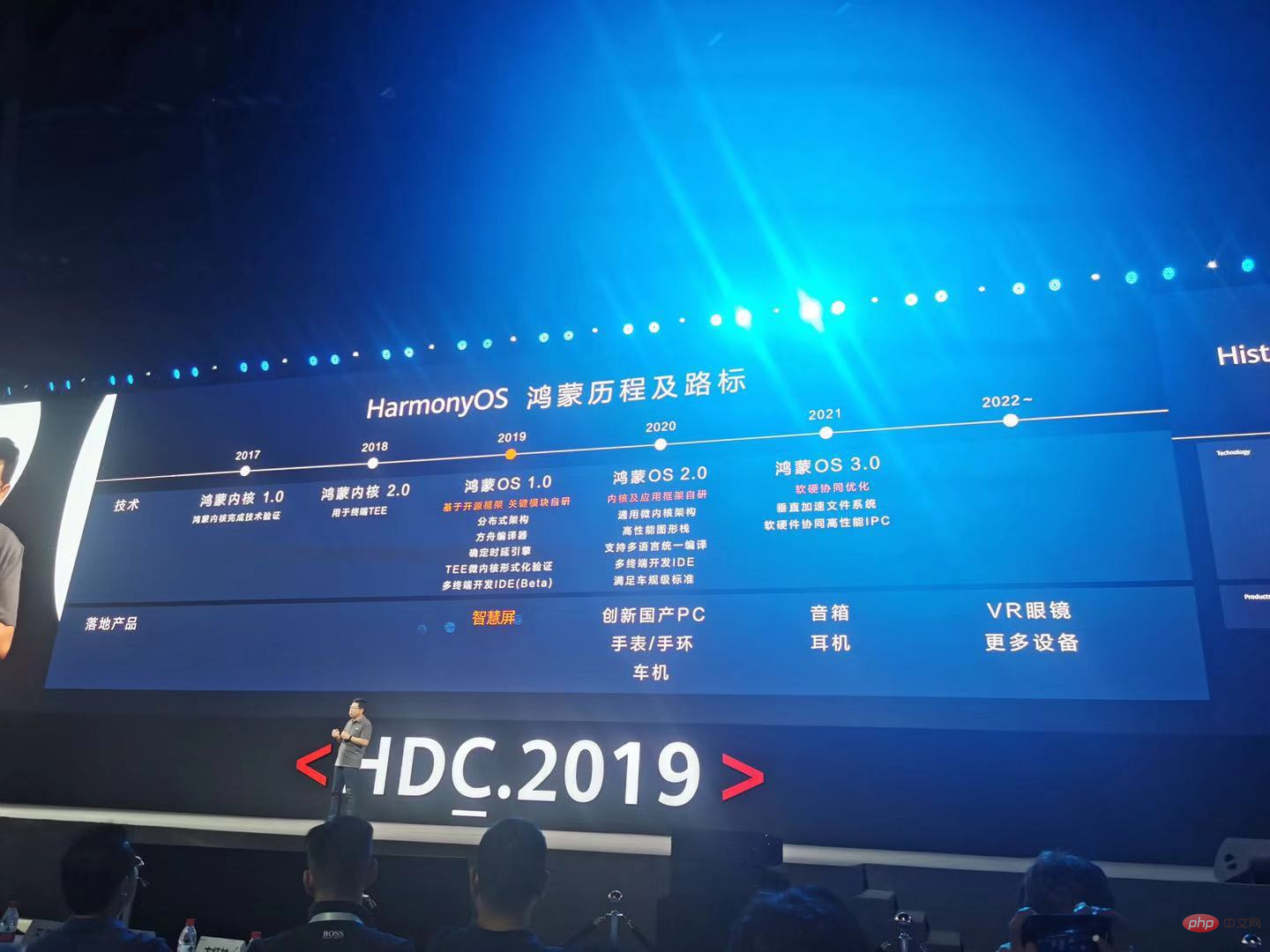
In addition, according to the Hongmeng OS roadmap released by Huawei, it is expected that by 2020, Hongmeng OS 2.0 will be implemented in innovative domestic PCs, watches/bracelets, and cars and other products. By 2021, it will also be used simultaneously on speakers, headphones and other devices.
Yu Chengdong also announced that Hongmeng system will be free and open source, and invited developers to develop this future-oriented system.
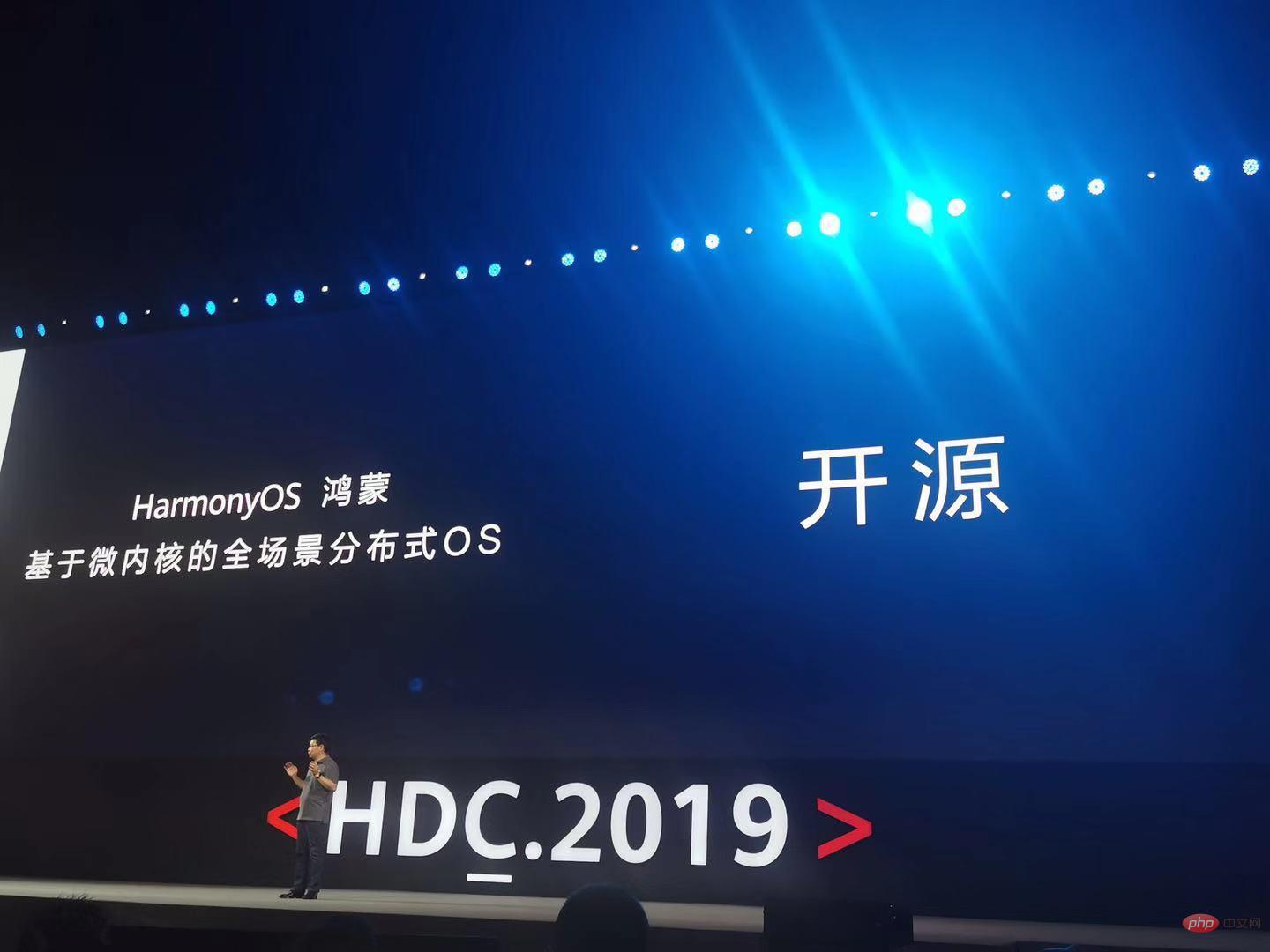
Priority supports Android, Hongmeng OS can be used at any time!
Previously, Ren Zhengfei said in an interview with the British media: "The Hongmeng system itself is not for mobile phones, but for the Internet of Things, such as autonomous driving and industrial automation. , because it can accurately control the delay below five milliseconds, even reaching millisecond level to sub-millisecond level."
As soon as this news came out, many developers felt a little disappointed and asked "Is Hongmeng OS Is it just an operating system for the Internet of Things?" question, and today, Yu Chengdong gave a clear answer. He said that Hongmeng OS can be used on a variety of devices, including watches, bracelets, cars, PCs, tablets, and of course Can be used on mobile phones. However, considering ecological reasons, the Google Android operating system is still preferred at the moment. If the Android operating system is unavailable, everyone can activate Hongmeng OS at any time.
HUAWEI Ark Compiler
The Huawei Ark Compiler, which is “derived from Android, better than Android, surpasses iOS, and fully compatible with Android”, brought great success when it was born. There is a great mission.
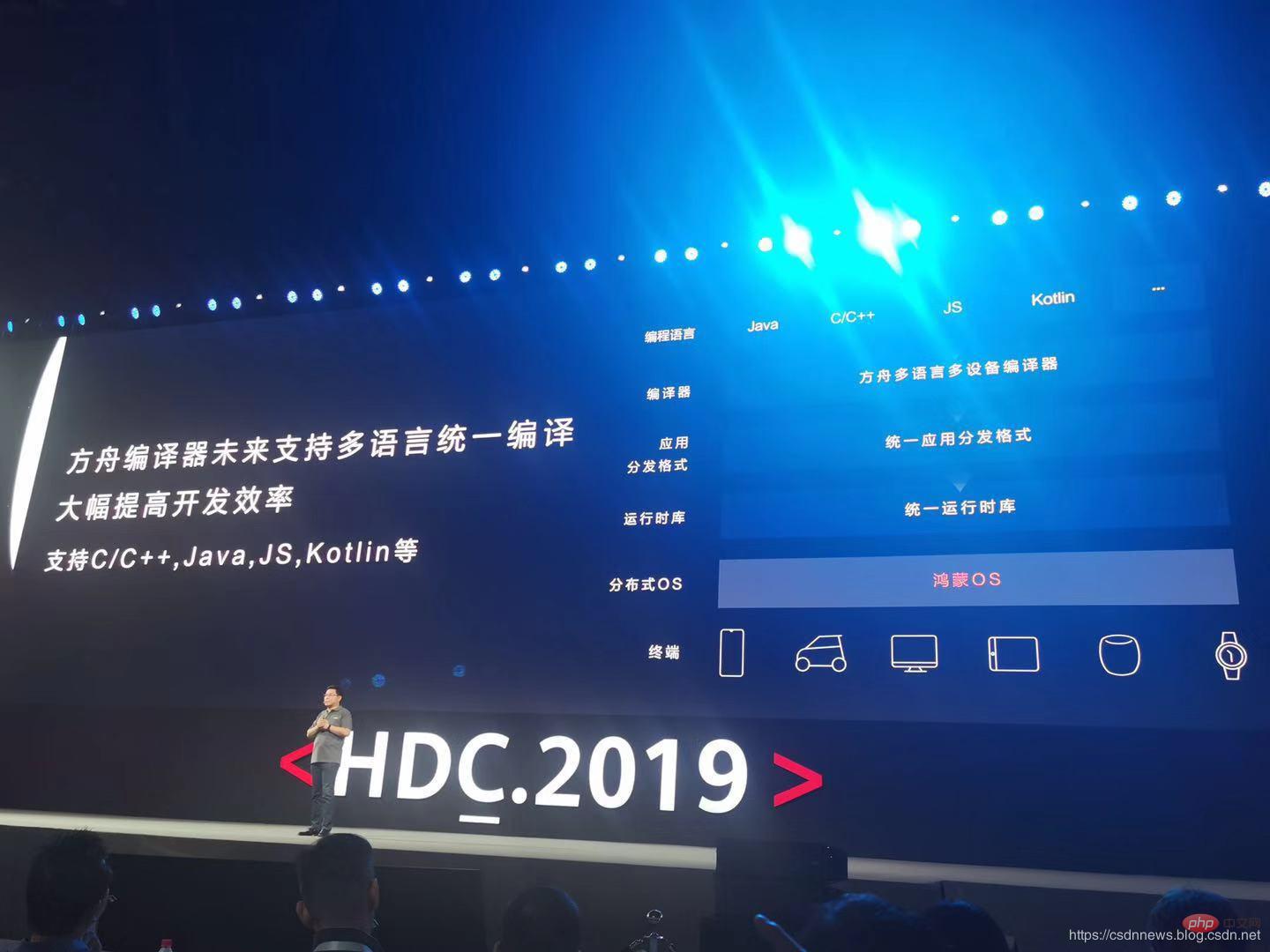 At the conference, Huawei Consumer Business CEO Yu Chengdong said that the Ark Compiler is a compiler that truly supports the unification of multiple programming languages and can support C/C, Java, JS, Kotlin and other languages. , which can help developers improve performance by more than 60%.
At the conference, Huawei Consumer Business CEO Yu Chengdong said that the Ark Compiler is a compiler that truly supports the unification of multiple programming languages and can support C/C, Java, JS, Kotlin and other languages. , which can help developers improve performance by more than 60%.
In addition, the Ark compiler also uses distributed capabilities to provide Kit to develop cross-terminal applications, including distributed soft bus Kit and so on.
The above is the detailed content of Huawei officially releases its own operating system - Hongmeng OS! (picture). For more information, please follow other related articles on the PHP Chinese website!

Hot AI Tools

Undresser.AI Undress
AI-powered app for creating realistic nude photos

AI Clothes Remover
Online AI tool for removing clothes from photos.

Undress AI Tool
Undress images for free

Clothoff.io
AI clothes remover

AI Hentai Generator
Generate AI Hentai for free.

Hot Article

Hot Tools

Notepad++7.3.1
Easy-to-use and free code editor

SublimeText3 Chinese version
Chinese version, very easy to use

Zend Studio 13.0.1
Powerful PHP integrated development environment

Dreamweaver CS6
Visual web development tools

SublimeText3 Mac version
God-level code editing software (SublimeText3)

Hot Topics
 1378
1378
 52
52
 Yu Chengdong steps down as CEO of Huawei Terminal BG, He Gang will take over
May 02, 2024 pm 04:01 PM
Yu Chengdong steps down as CEO of Huawei Terminal BG, He Gang will take over
May 02, 2024 pm 04:01 PM
According to multiple media reports, Huawei internally issued a personnel adjustment document on the afternoon of April 30, announcing that Yu Chengdong would step down as CEO of Huawei Terminal BG. Yu Chengdong will remain as chairman of Terminal BG. He Gang, the former Huawei Terminal BG and Chief Operating Officer, will take over the position of CEO of Huawei Terminal BG. According to reports, apart from the above-mentioned personal changes and adjustments, the document does not contain any more information. There is no further explanation on the background of this major personnel change and Yu Chengdong’s new business focus after stepping down as CEO of Terminal BG. Some sources said that this adjustment is a routine business structure adjustment, which will allow Yu Chengdong to have more energy to create high-quality products for consumers. Yu Chengdong was born in 1969. He graduated from the Automatic Control Department of Northwestern Polytechnical University with a bachelor's degree and a master's degree from Tsinghua University.
 HarmonyOS NEXT native intelligence opens up a new OS experience in the AI big model era! Huawei Xiaoyi turns into a smart body
Jun 22, 2024 am 02:30 AM
HarmonyOS NEXT native intelligence opens up a new OS experience in the AI big model era! Huawei Xiaoyi turns into a smart body
Jun 22, 2024 am 02:30 AM
AI large models have become a hot topic in the current technology circle. More and more companies are beginning to deploy large model capabilities, and more and more products are beginning to emphasize AI. However, judging from the current experience, most of the AI products flooding into the market often simply integrate large model applications at the application level, and do not realize systematic AI technology changes from the bottom up. At HDC2024, with the opening of HarmonyOSNEXT Beta to developers and pioneer users, Huawei demonstrated to the industry what true "native intelligence" is - with system-level AI capabilities, AI is no longer just an add-on to mobile phones, but is integrated with The operating system is deeply integrated and becomes a system-level core capability. According to reports, through the integration of software, hardware and core cloud, HarmonyO
 Xiaoyi upgraded to an intelligent agent! HarmonyOS NEXT Hongmeng native intelligence opens a new AI era
Jun 22, 2024 am 01:56 AM
Xiaoyi upgraded to an intelligent agent! HarmonyOS NEXT Hongmeng native intelligence opens a new AI era
Jun 22, 2024 am 01:56 AM
On June 21, Huawei Developer Conference 2024 (HDC2024) gathered again in Songshan Lake, Dongguan. At this conference, the most eye-catching thing is that HarmonyOSNEXT officially launched Beta for developers and pioneer users, and comprehensively demonstrated the three "king-breaking" innovative features of HarmonyOSNEXT in all scenarios, native intelligence and native security. HarmonyOSNEXT native intelligence: Opening a new AI era After abandoning the Android framework, HarmonyOSNEXT has become a truly independent operating system independent of Android and iOS, which can be called an unprecedented rebirth. Among its many new features, native intelligence is undoubtedly the new feature that can best bring users intuitive feelings and experience upgrades.
 Deploy large language models locally in OpenHarmony
Jun 07, 2024 am 10:02 AM
Deploy large language models locally in OpenHarmony
Jun 07, 2024 am 10:02 AM
This article will open source the results of "Local Deployment of Large Language Models in OpenHarmony" demonstrated at the 2nd OpenHarmony Technology Conference. Open source address: https://gitee.com/openharmony-sig/tpc_c_cplusplus/blob/master/thirdparty/InferLLM/docs/ hap_integrate.md. The implementation ideas and steps are to transplant the lightweight LLM model inference framework InferLLM to the OpenHarmony standard system, and compile a binary product that can run on OpenHarmony. InferLLM is a simple and efficient L
 Huawei WATCH 4 series launches HarmonyOS 4.2 Beta: new car control and other major features
Apr 25, 2024 pm 04:10 PM
Huawei WATCH 4 series launches HarmonyOS 4.2 Beta: new car control and other major features
Apr 25, 2024 pm 04:10 PM
According to news on April 25, Huawei recently launched the update push of HarmonyOS4.2Beta, which brings many new features to users, the most eye-catching of which is the addition of car control functions. According to user feedback, Huawei WATCH4 has added support for NFC car keys and Bluetooth car keys for Wenjie M9 and Zhijie S7 models in this update. This means that users can now unlock and start their cars directly from their watches, greatly improving ease of use. At the same time, the watch version of the AITO application has also been upgraded, providing users of Wenjie models with the ability to control the car by voice, including operations such as opening and closing the trunk, unlocking and locking. In addition, an exclusive watch face has been specially customized for Wenjie M9 to meet the user's personalization.
 Hongmeng Smart Travel S9 and full-scenario new product launch conference, a number of blockbuster new products were released together
Aug 08, 2024 am 07:02 AM
Hongmeng Smart Travel S9 and full-scenario new product launch conference, a number of blockbuster new products were released together
Aug 08, 2024 am 07:02 AM
This afternoon, Hongmeng Zhixing officially welcomed new brands and new cars. On August 6, Huawei held the Hongmeng Smart Xingxing S9 and Huawei full-scenario new product launch conference, bringing the panoramic smart flagship sedan Xiangjie S9, the new M7Pro and Huawei novaFlip, MatePad Pro 12.2 inches, the new MatePad Air, Huawei Bisheng With many new all-scenario smart products including the laser printer X1 series, FreeBuds6i, WATCHFIT3 and smart screen S5Pro, from smart travel, smart office to smart wear, Huawei continues to build a full-scenario smart ecosystem to bring consumers a smart experience of the Internet of Everything. Hongmeng Zhixing: In-depth empowerment to promote the upgrading of the smart car industry Huawei joins hands with Chinese automotive industry partners to provide
 180 devices can be upgraded to Hongmeng 4.2: more interesting and practical gameplay, worth over 10 million device upgrades
Jun 02, 2024 pm 03:39 PM
180 devices can be upgraded to Hongmeng 4.2: more interesting and practical gameplay, worth over 10 million device upgrades
Jun 02, 2024 pm 03:39 PM
On May 15, at Huawei's summer all-scenario new product launch conference, Huawei announced the HarmonyOS4.2 upgrade plan. This update will benefit up to 180 different devices, covering multiple categories such as mobile phones, tablets, headphones, and smart screens. . Since the public beta recruitment of HarmonyOS 4.2 on April 11, many products have been included in the HarmonyOS 4.2 upgrade. Between April and June, Huawei will continue to push HarmonyOS 4.2 to more models. Continue to expand! The number of ecological devices has exceeded 800 million units. At Huawei's summer all-scenario new product launch conference, Huawei announced that the number of Hongmeng ecological devices has exceeded the 800 million mark. At the same time, the popularity of the Hongmeng brand has also soared to 88%, making it a
 Introduction to Huawei Hongmeng system update and upgrade methods
May 06, 2024 pm 06:40 PM
Introduction to Huawei Hongmeng system update and upgrade methods
May 06, 2024 pm 06:40 PM
Huawei's Hongmeng system has attracted the attention of many users. This system is suitable for most Huawei mobile phones and supports ota upgrades. However, many users do not know how to upgrade. The following editor will introduce to you the update and upgrade methods of Huawei's Hongmeng system. . How to upgrade Huawei Hongmeng system 1. First open the Huawei phone and click. 2. Then find it in settings. 3. A software update prompt will appear, click on it. 4. It will then jump to the Hongmeng system update entrance. If there is no update interface, click to view it. 5. After the update is completed, return to the settings interface and click About Phone to see the Hongmeng system display. The mobile phone models supported by Hongmeng system support Huawei Mate40, Mate40Pro, Mate40Pro+, Mate4



